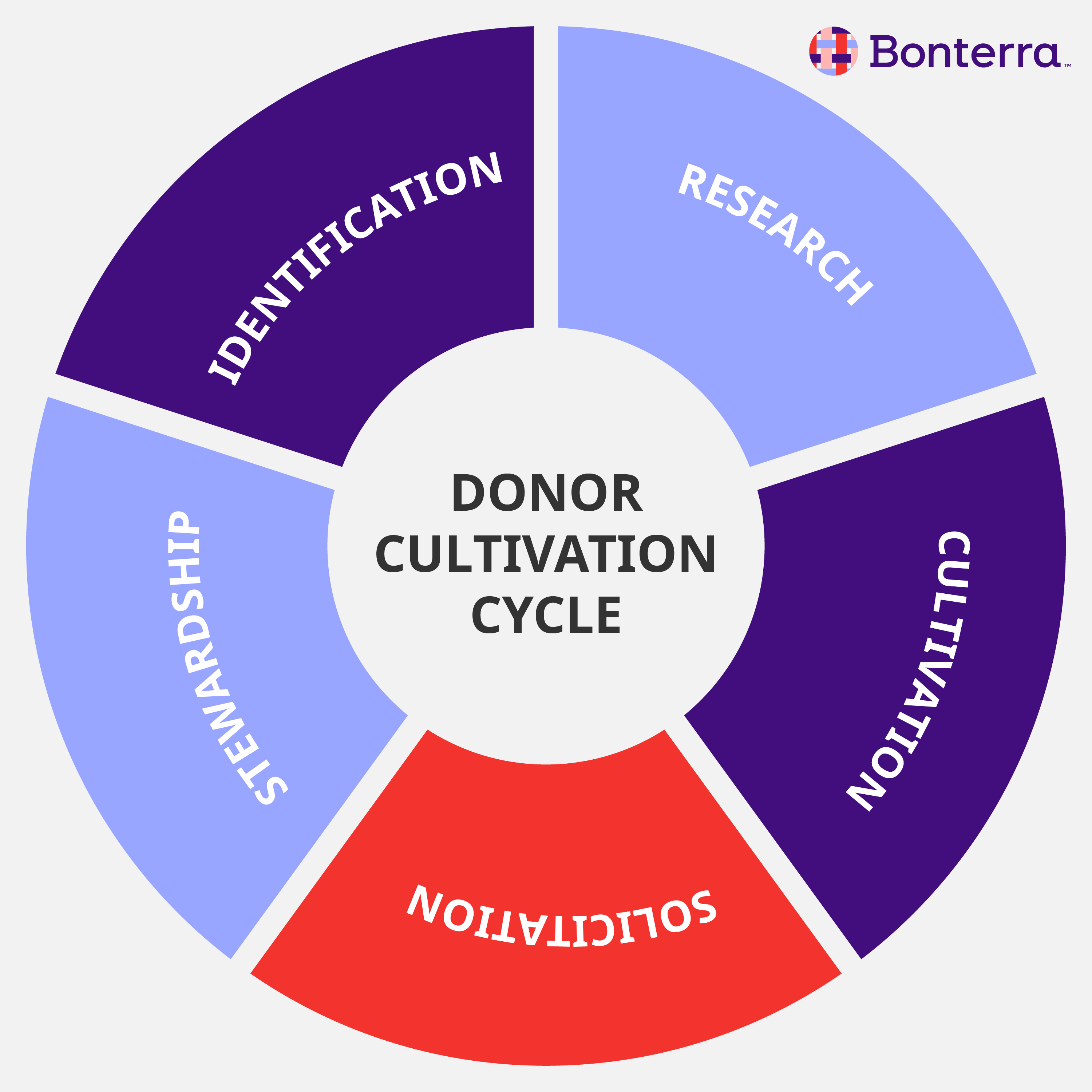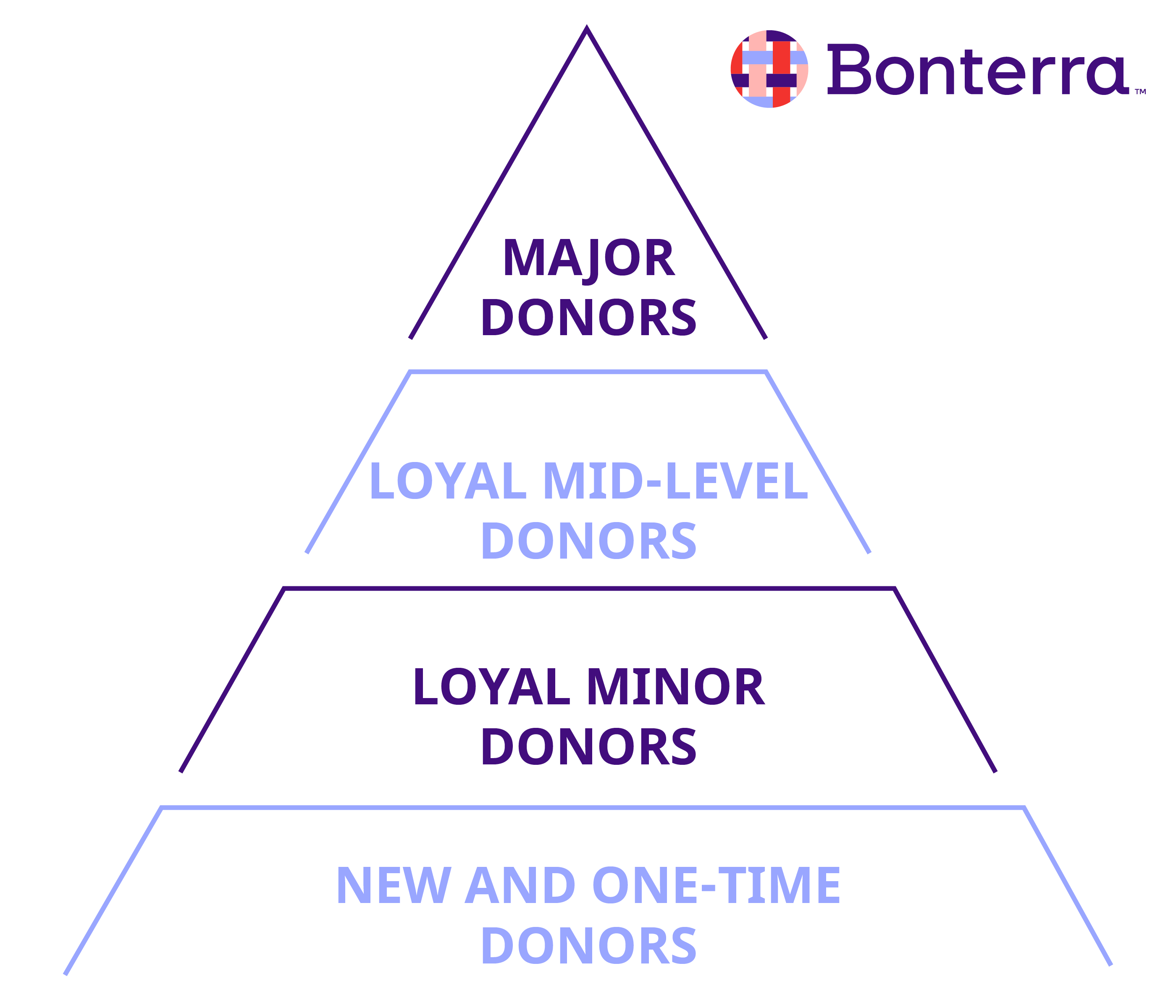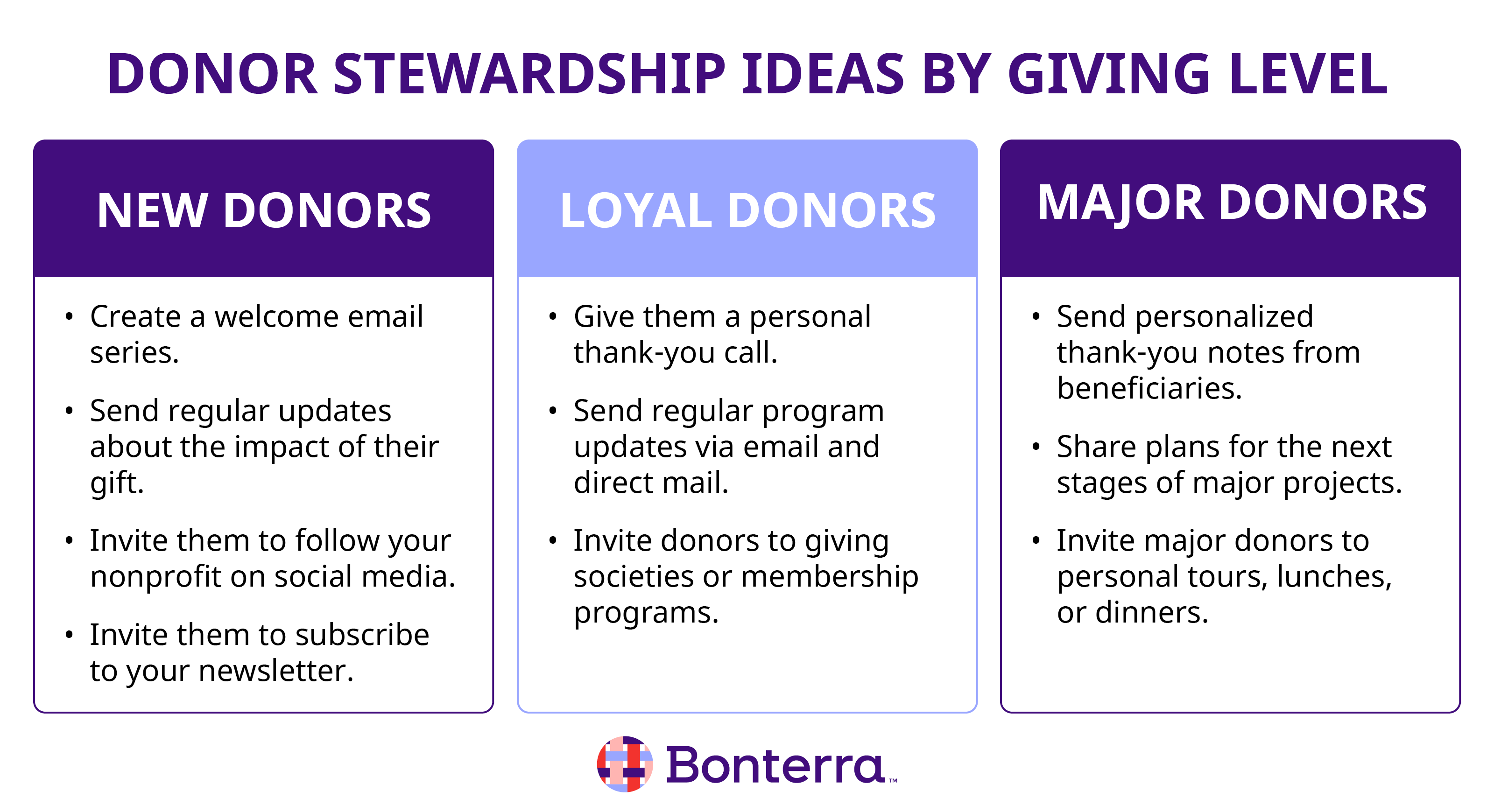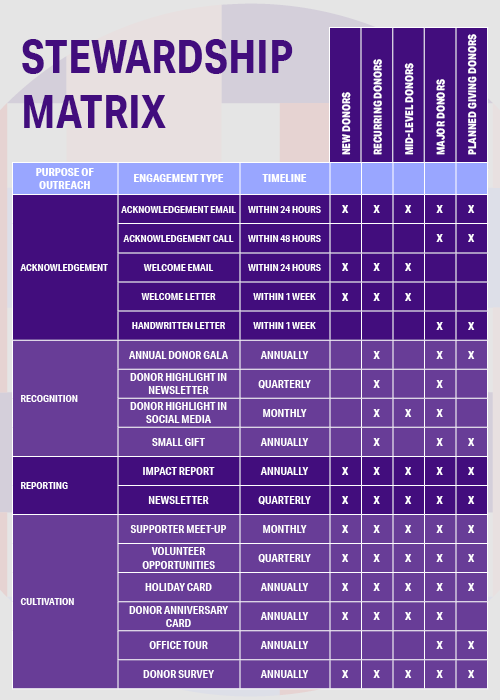A nonprofit organization’s success depends on the strength of its relationships with donors. These relationships are built on each donor’s sense of partnership and confidence that their gifts are making an impact. To strengthen these vital relationships and continue furthering your purpose, you need a donor stewardship strategy.
By implementing stewardship techniques, you can connect with donors on a deeper level and keep them engaged in your purpose long-term. In this guide, we’ll cover what donor stewardship is and how to create a stewardship plan for building meaningful relationships with each type of donor.

 In our example, we created levels for new and one-time donors, loyal minor donors, loyal mid-level donors, and major donors. However, you can make your nonprofit’s donor pyramid as detailed as needed, such as by adding a level for sustainers or planned giving donors.
In addition to segmenting your donors by donation type, you might also create segments according to their communication preferences or demographics. Utilizing your CRM to find this information will provide a roadmap for your stewardship plan, allowing you to strategically connect with supporters and increase their contributions.
In our example, we created levels for new and one-time donors, loyal minor donors, loyal mid-level donors, and major donors. However, you can make your nonprofit’s donor pyramid as detailed as needed, such as by adding a level for sustainers or planned giving donors.
In addition to segmenting your donors by donation type, you might also create segments according to their communication preferences or demographics. Utilizing your CRM to find this information will provide a roadmap for your stewardship plan, allowing you to strategically connect with supporters and increase their contributions.


What is donor stewardship?
Donor stewardship is the relationship-building process that occurs after a donor supports your organization. Stewardship focuses on nurturing long-term relationships by acknowledging donors’ gifts, inviting them to get more involved, and connecting with them through their preferred communication channels. The goal of donor stewardship is to build engagement and inspire ongoing support that increases over time. Successful stewardship ensures supporters have a positive experience with your nonprofit as a whole and encourages them to give again and again.Why is donor stewardship important for fundraising?
Donor stewardship is a key piece of your larger donor relations and fundraising strategies. To understand why it’s so important, let’s take a look at how donors move through their entire cultivation journey. The donor cultivation cycle has five phases:
- Identification: In this phase, your nonprofit seeks out and identifies potential donors based on their history with your organization and other financial and behavioral factors.
- Research: To get a better understanding of prospective donors and how to engage with them, nonprofit staff members research their interests and charitable histories. This is typically a more in-depth process for prospective major donors.
- Cultivation: Next, your team reaches out to prospects, shares information about your purpose, and offers them personalized ways to get involved.
- Solicitation: When your relationship with a prospect is strong enough, you’ll make your fundraising ask and solicit a donation.
- Stewardship: After securing a donation, strengthen and maintain that relationship by thanking the donor, keeping in touch, and providing meaningful ways for them to stay engaged with your purpose.
5 stages of effectively stewarding a donor
Donor stewardship relies on continuous communication and engagement to thank donors properly and put their gifts to good use. In practice, the process of stewarding a donor can be broken down into five main steps:1. Accept their donation
When you receive a donation, your organization should have a proper system in place to accept it. For instance, you might create a gift acceptance policy, a procedure used to manage donor expectations and guide your nonprofit through the process of asking for, receiving, and accepting donations. Specifically, this policy creates an efficient, standardized method for:- Reviewing each gift to ensure you can use it the way the donor intends
- Deciding how you’ll handle gifts if you can’t apply them the way donors request
- Tracking gifts to follow and report on how you used each one
- Handling in-kind and non-cash donations as well as monetary ones
2. Acknowledge and thank the donor for their gift
Donor acknowledgment is critical as it ensures your organization complies with legal regulations. The IRS requires nonprofit organizations to send a formal donation receipt letter to donors who give more than $250. This document recognizes their charitable donation and can be used by the donor to claim a tax deduction. An acknowledgment letter should include a brief expression of gratitude followed by your nonprofit’s name and the donation amount (or a description of a non-cash contribution if applicable). This satisfies the legal component of donor stewardship while improving relationships at the same time.3. Provide personalized recognition for their support
To begin the recognition process, follow up on each gift you receive with a sincere, personalized thank-you letter or email to show donors how much you value their support. Feel free to get creative with how you express your appreciation. Strong donor recognition strategies include:- Promptly following up with an email, phone call, and/or in-person meeting (depending on the gift size and pre-existing relationship with the donor). We recommend following up within 24 hours or one week at the latest
- Hosting donor recognition events to cultivate more face-to-face relationships and encourage higher levels of giving
- Featuring donors in your nonprofit’s newsletter, publication, annual report, or social media profiles to generate interest and celebrate them publicly
- Creating giving societies or honor rolls that offer tiered recognition levels and accompanying benefits
- Designing a physical or digital donor recognition wall that highlights major donors and other significant contributors to your cause
4. Communicate the tangible impact of their donation
While donors value acknowledgment and recognition, they also want to see the impact of their gifts. Communicating your results back to donors keeps them well-informed about how you’ve used their gifts and helps you cultivate trust within these relationships. Consider the following ways to report the impact of a gift as part of your donor stewardship strategy:- Send fundraising campaign updates via email, text, or direct mail
- Feature genuine, compelling stories of how donations help beneficiaries in your newsletter
- Post regular progress updates on social media and your nonprofit’s blog
- Create case studies for your website highlighting the communities you serve
5. Cultivate the relationship by keeping in touch
During the final stage of the donor stewardship process, focus on motivating donors to continue giving or increase their support. Keep the emphasis on relationship-building rather than further solicitation to develop deep, positive connections with donors. To encourage commitment to your organization, you might:- Share plans for the next stages of projects that donors gave to in the past
- Suggest related programs donors could be interested in supporting based on their interests and giving history
- Ask donors to spread the word about a project or program they’re passionate about on social media
- Invite donors to a fundraising event, volunteer opportunity, or tour of your headquarters to see the results of their gifts firsthand
How to create a donor stewardship plan
A donor stewardship plan is a detailed outline of a nonprofit’s processes and strategies to keep donors engaged by showing them their impact and building lasting relationships. Since there are so many stewardship techniques that organizations can use to connect with donors, creating a clear plan ensures that your nonprofit takes a data-informed, strategic approach, making your efforts as effective as possible. To create your own plan, follow these steps:1. Create a donor pyramid to identify giving levels
Before you create a donor stewardship plan, segment your donors based on their gift frequency, size, and type. These categories will be your donor giving levels and will serve as the framework for your stewardship plan. To easily identify these levels, create a donor pyramid like the one below. This donor stewardship tool divides your donor base into a few core giving levels to help you craft specific stewardship strategies that resonate with each group. A donor pyramid also allows you to easily visualize one of the core goals of donor stewardship: to move donors to higher giving levels over time. In our example, we created levels for new and one-time donors, loyal minor donors, loyal mid-level donors, and major donors. However, you can make your nonprofit’s donor pyramid as detailed as needed, such as by adding a level for sustainers or planned giving donors.
In addition to segmenting your donors by donation type, you might also create segments according to their communication preferences or demographics. Utilizing your CRM to find this information will provide a roadmap for your stewardship plan, allowing you to strategically connect with supporters and increase their contributions.
In our example, we created levels for new and one-time donors, loyal minor donors, loyal mid-level donors, and major donors. However, you can make your nonprofit’s donor pyramid as detailed as needed, such as by adding a level for sustainers or planned giving donors.
In addition to segmenting your donors by donation type, you might also create segments according to their communication preferences or demographics. Utilizing your CRM to find this information will provide a roadmap for your stewardship plan, allowing you to strategically connect with supporters and increase their contributions.
2. Outline your donor stewardship activities
You have a wide range of stewardship methods to choose from, so start by brainstorming techniques for donors in each of your core giving levels. Outline specific techniques for acknowledgment, recognition, reporting, and cultivation. For example, you might designate the following stewardship strategies for different giving levels:
New donors
First-time donors want to learn more about your purpose and impact since they’re just beginning their journey with your nonprofit. Build trust and give them confidence that your organization can make the impact that they want to see in the world with the following stewardship strategies:- Send an immediate, personalized gift receipt that mentions the specific project or program that the gift will support
- Create an email welcome series to welcome them into your donor community.
- Keep thank-you letters and emails focused on the donor and community that will benefit from their gift
- Send regular communications that update the donor on the impact of their gift and the project’s progress
- Invite the donor to engage with your organization on social media
- Invite the donor to subscribe to your newsletter
- Ask new donors to spread the word about the project or program they’re passionate about
Loyal donors
Loyal donors may include minor and mid-level donors who have given multiple donations. These donors have developed trust in your organization and give reliably when you make an appeal. Try these stewardship suggestions to retain their ongoing support and encourage them to give more over time:- When a donor makes a monthly gift commitment or gives a larger gift, follow up with a phone call in addition to the initial thank-you letter or email
- Send program or project updates via email and direct mail
- Share impact reports regularly
- Invite donors to giving societies or membership programs that include perks and build a sense of community
- Adopt membership management software to streamline the member experience and offer exclusive benefits
- Offer special volunteer opportunities for donors to get more involved
Major donors
Major donors have chosen to partner with your organization at a high giving level. They’re fully committed to your cause and should receive special attention to maintain their engagement. Nurture these donors and encourage them to continue giving with personal, one-on-one relationship-building activities. Here are some ways you can steward major donors:- Send a personalized thank-you note from beneficiaries impacted by the donor’s gift
- Share plans for the next stages of projects that donors have given to in the past
- Invite donors to an onsite event or tour to see the results of their gifts firsthand
- Invite donors to lunch or coffee with a board member to show your gratitude
- Host special donor appreciation events
- Feature major donors in your annual reports
- Send tailored articles and other information of interest to donors
3. Create a stewardship matrix
Now that you’ve chosen your donor stewardship techniques, create a detailed schedule that outlines the specific points and timeframes of how and when you’ll communicate with donors. This is called a donor stewardship matrix. Your stewardship matrix should organize your stewardship efforts according to giving level, timeline, and engagement type, making it easy to follow through on every step of the plan. Explore our example stewardship matrix below to see what this looks like in practice.
4. Evaluate and refine your donor stewardship plan
Your donor stewardship plan should be a living document that you change and improve as you receive feedback and new ideas. Schedule a regular review process to assess your plan and gather feedback and data. For the best results, look at both quantitative and qualitative information by:- Tracking key performance indicators, such as retention rates, conversion rates, and average gift amounts
- Surveying donors about the strengths and weaknesses of your stewardship program
Strengthening relationships with your donor stewardship plan
Whether you’re a team of one or a department of 20, creating a defined stewardship plan will help you improve your donor retention rate, encourage donors to give more, and build a meaningful community that they can believe in. Remember that the purpose of donor stewardship is to give back some of the dedication that your donors have shown you. By investing time and effort into this process and using powerful tools that enable you to track and personalize stewardship efforts, you’ll cultivate a base of loyal, committed supporters for your nonprofit.
Steward donors with an intelligent, unified fundraising platform




